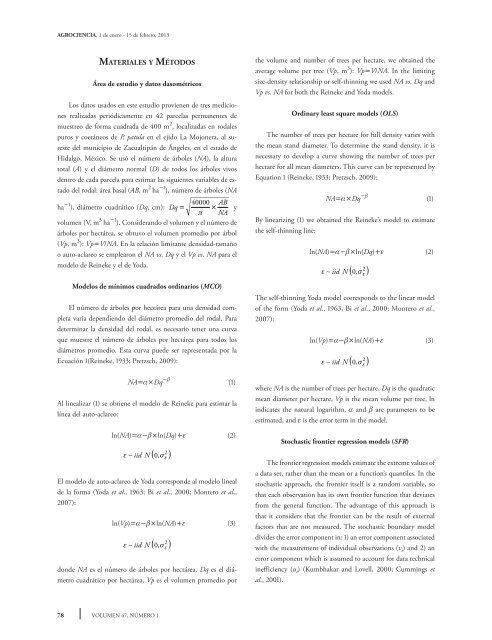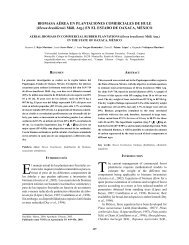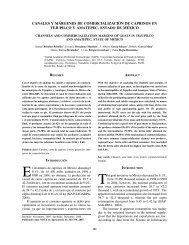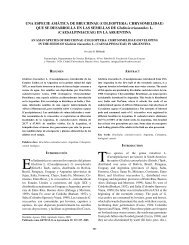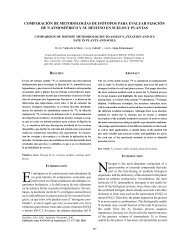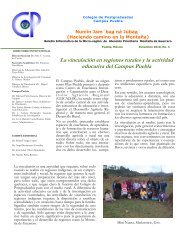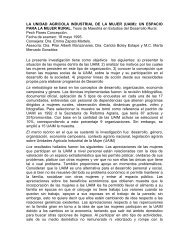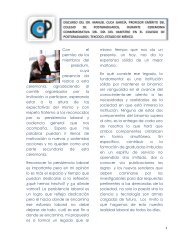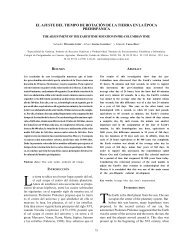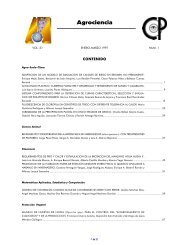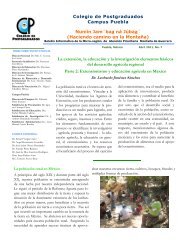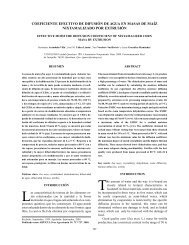AUTO-ACLAREO Y GUÍAS DE DENSIDAD PARA Pinus patula ...
AUTO-ACLAREO Y GUÍAS DE DENSIDAD PARA Pinus patula ...
AUTO-ACLAREO Y GUÍAS DE DENSIDAD PARA Pinus patula ...
You also want an ePaper? Increase the reach of your titles
YUMPU automatically turns print PDFs into web optimized ePapers that Google loves.
AGROCIENCIA, 1 de enero - 15 de febrero, 2013<br />
78<br />
mAteRIAles y métodos<br />
Área de estudio y datos dasométricos<br />
Los datos usados en este estudio provienen de tres medicio-<br />
nes realizadas periódicamente en 42 parcelas permanentes de<br />
muestreo de forma cuadrada de 400 m 2 , localizadas en rodales<br />
puros y coetáneos de P. <strong>patula</strong> en el ejido La Mojonera, al su-<br />
reste del municipio de Zacualtipán de Ángeles, en el estado de<br />
Hidalgo, México. Se usó el número de árboles (NA), la altura<br />
total (A) y el diámetro normal (D) de todos los árboles vivos<br />
dentro de cada parcela para estimar las siguientes variables de es-<br />
tado del rodal: área basal (AB, m 2 ha 1 ), número de árboles (NA<br />
ha 1 ), diámetro cuadrático (Dq, cm): Dq<br />
VOLUMEN 47, NÚMERO 1<br />
40000 AB<br />
= ×<br />
π NA<br />
volumen (V, m 3 ha 1 ). Considerando el volumen y el número de<br />
árboles por hectárea, se obtuvo el volumen promedio por árbol<br />
(Vp, m 3 ): VpV/NA. En la relación limitante densidad-tamaño<br />
o auto-aclareo se emplearon el NA vs. Dq y el Vp vs. NA para el<br />
modelo de Reineke y el de Yoda.<br />
Modelos de mínimos cuadrados ordinarios (MCO)<br />
El número de árboles por hectárea para una densidad com-<br />
pleta varía dependiendo del diámetro promedio del rodal. Para<br />
determinar la densidad del rodal, es necesario tener una curva<br />
que muestre el número de árboles por hectárea para todos los<br />
diámetros promedio. Esta curva puede ser representada por la<br />
Ecuación 1(Reineke, 1933; Pretzsch, 2009):<br />
NADq (1)<br />
Al linealizar (1) se obtiene el modelo de Reineke para estimar la<br />
línea del auto-aclareo:<br />
ln(NA)ln(Dq) (2)<br />
( )<br />
εiid N 0 σε 2<br />
,<br />
El modelo de auto-aclareo de Yoda corresponde al modelo lineal<br />
de la forma (Yoda et al., 1963; Bi et al., 2000; Montero et al.,<br />
2007):<br />
ln(Vp)ln(NA) (3)<br />
( )<br />
εiid N 0 σε 2<br />
,<br />
donde NA es el número de árboles por hectárea, Dq es el diá-<br />
metro cuadrático por hectárea, Vp es el volumen promedio por<br />
y<br />
the volume and number of trees per hectare, we obtained the<br />
average volume per tree (Vp, m 3 ): VpV/NA. In the limiting<br />
size-density relationship or self-thinning we used NA vs. Dq and<br />
Vp vs. NA for both the Reineke and Yoda models.<br />
Ordinary least square models (OLS)<br />
The number of trees per hectare for full density varies with<br />
the mean stand diameter. To determine the stand density, it is<br />
necessary to develop a curve showing the number of trees per<br />
hectare for all mean diameters. This curve can be represented by<br />
Equation 1 (Reineke, 1933; Pretzsch, 2009):<br />
NADq (1)<br />
By linearizing (1) we obtained the Reineke’s model to estimate<br />
the self-thinning line:<br />
ln(NA)ln(Dq) (2)<br />
( )<br />
εiid N 0 σε 2<br />
,<br />
The self-thinning Yoda model corresponds to the linear model<br />
of the form (Yoda et al., 1963, Bi et al., 2000; Montero et al.,<br />
2007):<br />
ln(Vp)ln(NA) (3)<br />
( )<br />
εiid N 0 σε 2<br />
,<br />
where NA is the number of trees per hectare, Dq is the quadratic<br />
mean diameter per hectare, Vp is the mean volume per tree, ln<br />
indicates the natural logarithm, and are parameters to be<br />
estimated, and is the error term in the model.<br />
Stochastic frontier regression models (SFR)<br />
The frontier regression models estimate the extreme values of<br />
a data set, rather than the mean or a function’s quantiles. In the<br />
stochastic approach, the frontier itself is a random variable, so<br />
that each observation has its own frontier function that deviates<br />
from the general function. The advantage of this approach is<br />
that it considers that the frontier can be the result of external<br />
factors that are not measured. The stochastic boundary model<br />
divides the error component in: 1) an error component associated<br />
with the measurement of individual observations (v i ) and 2) an<br />
error component which is assumed to account for data technical<br />
inefficiency (u i ) (Kumbhakar and Lovell, 2000; Cummings et<br />
al., 2001).


